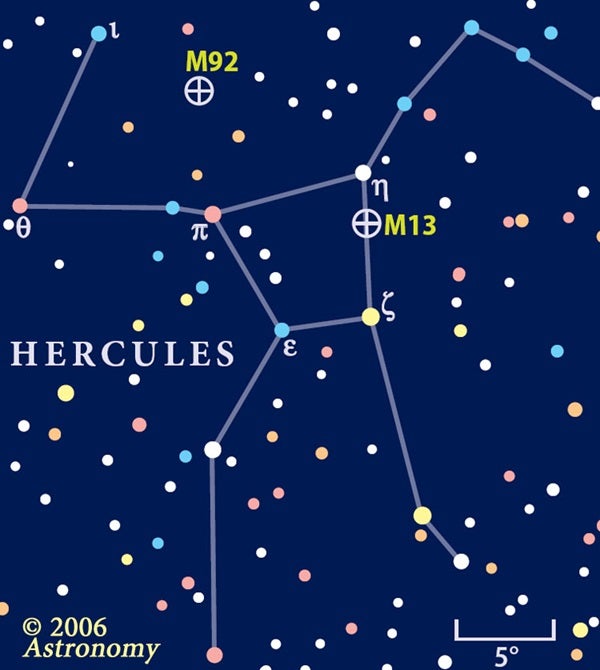Four of Hercules’ brightest stars fall into a keystone pattern that contains this month’s first binocular target. The great Hercules globular cluster M13 (NGC 6205) resides along the western side of the keystone, about a quarter of the way between the stars Eta (η) and Zeta (ζ) Herculis. Aim there, and you should see a faint blur of light centered between two faint “sentry stars” standing at attention to either side. Through binoculars, M13 looks like a fluffy cotton ball suspended against the sky. You’ll need a telescope to see any of its estimated 100,000 individual stars.
Can you imagine what a spectacular sight those stars must be from a planet orbiting one of them? Isaac Asimov’s famous science-fiction story Nightfall tells of a civilization on the planet Lagash, which orbits a six-star system. Lagash’s complex orbit was such that at least one of those six stars always lit the planet’s sky. No one alive had witnessed night’s darkness. But once every 2,049 years, five of the stars would be visible only from one side of the planet, while an eclipse would cover the sixth star on the other side. On that occasion, the sky would be completely dark.
Learning that an eclipse was imminent and not knowing what darkness is, the people of Lagash were stricken with fear and madness over the pending terror. But just as the eclipse occurred, and the planet’s lone remaining sun was extinguished, the entire sky suddenly burst with uncountable distant stars. It turned out that Lagash lies within a globular cluster.
Hercules holds in store a second globular, M92 (NGC 6341), for our binoculars. To spot it, aim along the northern side of the Hercules keystone, marked by the stars Eta and Pi (π) Herculis. Both ought to fit in the field of view. Look for a tight pair of fainter stars to their north; Eta, Pi, and this pair combine to form a fairly conspicuous right triangle. From that fainter pair, which collectively marks the triangle’s right angle, head north-northeast about half a field (3°) to M92. Like M13, M92 will look like a misty glow accented with a brighter central core. Both globulars may squeeze into the same field of wide-angle binoculars.
Let’s try to find a fun asterism that isn’t plotted on any star chart I know about. A couple of months ago, I bumped into it while doing some early morning observing for this column. I jokingly call it the SS Hercules, because it reminds me of a sailboat. To find it, head about a binocular field (5°) northeast of M92, to the star Iota (ι) Herculis, and then another half a field (3°) due east. There, you should see a group of seven stars. To me, the two brightest form the mast, three fainter stars outline the deck, and two others mark the underside of the hull. Drop me a line here and let me know if you spot the good ship SS Hercules.
Plenty of other treats lie in the constellation Hercules to entertain us this month. Come over to Astronomy.com, where I spell a few of them out. And next month, we’ll cruise the Milky Way toward the galactic center, where, once again, we will prove two eyes are better than one!











